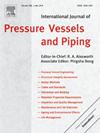Cu和Ni对Al-Mg-Si合金TIG焊接的冶金、力学和腐蚀行为的影响
IF 3
2区 工程技术
Q2 ENGINEERING, MECHANICAL
International Journal of Pressure Vessels and Piping
Pub Date : 2025-04-24
DOI:10.1016/j.ijpvp.2025.105533
引用次数: 0
摘要
Al-Mg-Si合金由于其良好的性能在汽车和航空航天工业中得到了广泛的应用。然而,在保持焊接性的同时提高其机械性能和耐腐蚀性仍然是一个挑战。研究了Cu和Ni涂层对Al-Mg-Si tig焊接接头组织、力学性能和腐蚀行为的影响。焊接前在AlSi5填充棒上电镀不同厚度的Cu和Ni涂层。采用光学显微镜、扫描电镜、显微硬度测试、拉伸测试、冲击测试和电化学腐蚀测试对焊接接头进行了表征。焊缝中的Cu含量从0.11 wt%(未涂层)增加到0.92 wt%(最厚的Cu涂层),而混合涂层达到0.51 wt% Cu + 0.48 wt% Ni。铜含量为0.69 wt%的样品显示出最高的整体硬度,焊缝上部硬度高达89.5±1.9 HV,比未涂覆的样品提高了36.9%。当Cu含量为0.69 wt%时,拉伸强度提高35.4%,达到295.5±5.3 MPa,冲击韧性提高28.6%。当Cu含量达到0.69 wt%时,样品的耐蚀性也有所提高,腐蚀速率比未涂覆样品降低了44.9%。Cu和Ni涂层显著提高了Al-Mg-Si tig焊接接头的组织、力学性能和耐蚀性。本文章由计算机程序翻译,如有差异,请以英文原文为准。

Influence of Cu and Ni addition on metallurgical, mechanical, and corrosion behavior of TIG welded Al-Mg-Si alloy
Al-Mg-Si alloys are widely used in the automotive and aerospace industries due to their favorable properties. However, improving their mechanical behavior and corrosion resistance while maintaining weldability remains a challenge. This study investigated the effects of Cu and Ni coatings on the microstructure, mechanical properties, and corrosion behavior of TIG-welded Al-Mg-Si joints. AlSi5 filler rods were electroplated with Cu and Ni coatings of varying thicknesses before welding. The welded joints were characterized using optical microscopy, SEM, microhardness testing, tensile testing, impact testing, and electrochemical corrosion testing. Cu content in the welds increased from 0.11 wt% (uncoated) to 0.92 wt% (thickest Cu coating), while a hybrid coating achieved 0.51 wt% Cu + 0.48 wt% Ni. The 0.69 wt% Cu sample exhibited the highest overall hardness, with up to 89.5 ± 1.9 HV in the upper weld zone, a 36.9 % increase compared to the uncoated sample. Tensile strength increased by 35.4 % for the 0.69 wt% Cu sample, reaching 295.5 ± 5.3 MPa, while impact toughness improved by 28.6 %. Corrosion resistance also improved with Cu content up to 0.69 wt%, with the corrosion rate decreasing by 44.9 % compared to the uncoated sample. Cu and Ni coatings significantly enhanced the microstructure, mechanical properties, and corrosion resistance of TIG-welded Al-Mg-Si joints.
求助全文
通过发布文献求助,成功后即可免费获取论文全文。
去求助
来源期刊
CiteScore
5.30
自引率
13.30%
发文量
208
审稿时长
17 months
期刊介绍:
Pressure vessel engineering technology is of importance in many branches of industry. This journal publishes the latest research results and related information on all its associated aspects, with particular emphasis on the structural integrity assessment, maintenance and life extension of pressurised process engineering plants.
The anticipated coverage of the International Journal of Pressure Vessels and Piping ranges from simple mass-produced pressure vessels to large custom-built vessels and tanks. Pressure vessels technology is a developing field, and contributions on the following topics will therefore be welcome:
• Pressure vessel engineering
• Structural integrity assessment
• Design methods
• Codes and standards
• Fabrication and welding
• Materials properties requirements
• Inspection and quality management
• Maintenance and life extension
• Ageing and environmental effects
• Life management
Of particular importance are papers covering aspects of significant practical application which could lead to major improvements in economy, reliability and useful life. While most accepted papers represent the results of original applied research, critical reviews of topical interest by world-leading experts will also appear from time to time.
International Journal of Pressure Vessels and Piping is indispensable reading for engineering professionals involved in the energy, petrochemicals, process plant, transport, aerospace and related industries; for manufacturers of pressure vessels and ancillary equipment; and for academics pursuing research in these areas.

 求助内容:
求助内容: 应助结果提醒方式:
应助结果提醒方式:


